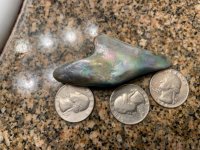Technological Breakthrough in Pearl Culture: Cultured (Beaded) Abalone Pearls from Chile
In what appears to be a major technological breakthrough in Pearl Aquaculture, Chilean Scientists from the University of Antofagasta, Chile have been successful in culturing bead nucleated cultured pearls on the “Red Abalone” (Haliotis rufescens) a species that was imported into Chile from Mexico back in the 1990s. Ever since, Chile has been a major producer of farm raised abalone, but just over a decade ago they started looking into culturing Mabe and cultured pearls. Their efforts have finally borne fruit!
As you may already know, the main issue behind Abalone pearl culture is that these organisms will not be able to clot their wounds, thus they die by bleeding, a haemophile effect of sorts. Their delicate surgical procedures have been able to produce the first cultured pearls from this family of mollusks (family Haliotidae) that comprise up to 130 different species worldwide (see this article for more information), but that have been grown for mostly for their delicious “meat” (the large foot of the animal). Abalone belong to a group of marine snails known as “Archaic Gastropods” (Vetigastropoda) which come from an ancient lineage, but that sometimes are confused as “clams” by some people, due to the shape of their shells.
A large “Silver Lip pearl oyster” shell (30 cm in diameter) next to an even larger (40 cm in diameter) “Red Abalone” shell.
The team -led by Dr. Rubén Araya Valencia of the University of Antofagasta’s Technological program- behind these “impossible” to produce pearls has been able to produce Mabe pearls (something that had already been done in Canada, the United States and Mexico, but the main producer is New Zealand, read more about this subject here) and by means of their unique techniques they have been able to have post-operatory mortality rates of less than 1%, with just around 35% rejection (very much in line with other saltwater pearl operations). They have been able to patent their technology in Chile, Australia, South Africa, Korea and Mexico so far, with other Nations still pending.
These pearls clearly show the unique natural traits of Abalone pearls, such as their baroque shapes and beautiful blue-green coloration and lavender overtones, as well as other easily identifiable such as the presence of dark protein deposits. These first pearls also display a unique tapered look, probably due to the way the pearl sac heals within the organism’s body.
But in all, these pearls may also drive renewed excitement in the pearl world, just by offering an entirely new variety of cultured pearl to both consumers and designers. Welcome to our Pearl World!


